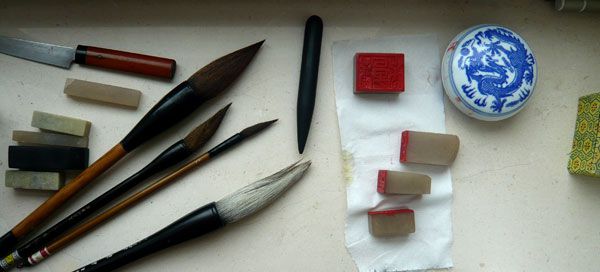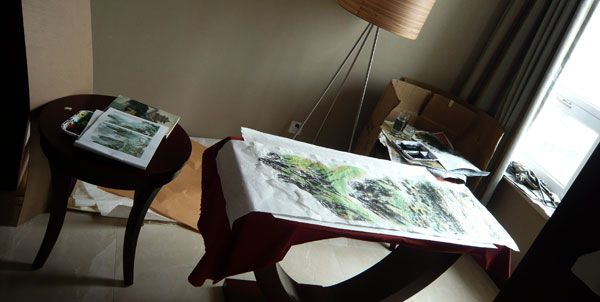In September 2010, during a trip to China, I discovered "traditional" ink painting unexpectedly. Flowers and branches of cherry, birds, horses ... I am interested in everything, especially the landscapes in black and white. I brought back home some Maupi (brushes) and papers: I paint, I throw away, I paint, I throw away...

The following year, I was invited to join a sculpture symposium, in China once again. I knew that I would have time to continue my apprenticeship. I searched libraries, antique dealers, art stores… I found books, met professionals and enthusiasts, everybody spoke Chinese, but I was eager for knowledge and practice.

"I often stay at the hotel. Breakfast, lunch and dinner mark the rhythm of my days. I transformed one of the rooms in my "suite" into a workshop and I paint from dawn to dusk when I don’t need to get out. I paint a lot and I throw away a lot. About one out of ten inks satisfies me. The rest goes to the trash. My level of requirement is at his maximum. My inks are mounted on large pieces of fabrics the traditional Chinese way, in rolls. It is very beautiful and I am cheerful of the result. I am now ready to organize my first exhibition of inks in Tahiti. ». 'O FENUA' October 2011

Since then, I paint nature a lot, using brush pens filled with ink or water, in any weather condition: sun, rain, wind, snow ... I fill in sketchbooks, then travel logs: Japan, China, Polynesia, France, Latin America...

I find the Chinese papers very sensual, almost alive, semi-transparent like skin. A beautiful ink gives infinity of nuances. Back in my workshop, I express my travelling feelings on large sheets. It is a question of capturing the forces of nature in action, the breath of life, the beauty, the strength of the place and the moment, the light, the magic.

O Fenua, encres de GOTZ O Dufant
Exhibition:
2011 O Fenua exposition Galerie des tropiques Tahiti
Wang Wei sas:
The mountain is encircled with clouds, rocks conceal springs, pavilions and terraces are surrounded by trees, trails bear traces of men.
A rock must be seen from three sides, a path may be taken by its two ends, a tree is perceived according to his top, water is felt through the wind that runs through it.
Consider atmospheric manifestations first. Distinguish what is bright from what is dark, what is sharp from what is blur.
Establish the hierarchy between the figures, fix their attitudes, their gait, their reciprocal greetings. Too many elements result in a risk of congestion, too little can be perceived as relaxation.
Grasp the exact measure and the right distance, so there is a vacuum between the distant and the near, both for mountains and watercourses.
François Cheng, "Vide et plein le langage pictural Chinois"
 English (UK)
English (UK)  Français (FR)
Français (FR)